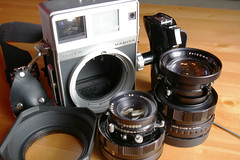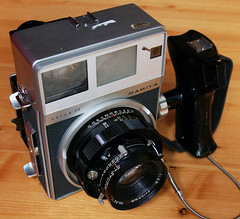Difference between revisions of "Mamiya Press"
(Revised and added info on fiolm backs.) |
m |
||
| Line 4: | Line 4: | ||
===Lens System=== | ===Lens System=== | ||
| − | The lens system incorporates a mount unique to the Mamiya Press, and each lens is mounted in a [[Hattori|Seikosha]] [[leaf shutter]]. Lenses of fixed focal lengths from 50mm to 250mm were produced, all of which covered up to 2x3 film sheets. Lenses produced include: | + | The lens system incorporates a mount unique to the Mamiya Press, and each lens is mounted in a [[Hattori|Seikosha]] [[leaf shutter]]. Lenses of fixed focal lengths from 50mm to 250mm were produced, all of which covered up to 2x3 film sheets, while the 127mm and 75mm lenses offered greater coverage necessary for the 2 7/8 x 3 3/4 inch images produced bay the Polaroid backs. |
| + | Lenses produced include: | ||
{| class="plainlinks floatright" style="text-align: center;" | {| class="plainlinks floatright" style="text-align: center;" | ||
|- | |- | ||
Revision as of 03:24, 10 May 2008
The Mamiya Press is a medium format rangefinder camera system designed to accept interchangeable backs and lenses. Mamiya made a number of variants to the basic body design, including one model, the 600SE, that was licensed to be marketed under the Polaroid name. The camera body itself is a simple affair, with a single-window combined range- and view-finder that couples to the lens for focusing. It has tripod mounts in both vertical and horizontal positions, a mount for a handgrip for the left hand, and cold shoes on both the body and the handgrip.
Contents
Lens System
The lens system incorporates a mount unique to the Mamiya Press, and each lens is mounted in a Seikosha leaf shutter. Lenses of fixed focal lengths from 50mm to 250mm were produced, all of which covered up to 2x3 film sheets, while the 127mm and 75mm lenses offered greater coverage necessary for the 2 7/8 x 3 3/4 inch images produced bay the Polaroid backs. Lenses produced include:

|
| 100 f/3.5 and 100mm f/2.8 lenses. Picture courtesy Apocaplops. (Image rights) |
- 50mm f/6.3
- 65mm f/6.3
- 75mm f/5.6
- 90mm f/3.5
- 100mm f/3.5
- 100mm f/2.8
- 127mm f/4.7
- 150mm f/5.6
- 250mm f/8 (not rangefinder coupled)
- 250mm f/5
Film Backs & Accessories
Two different types of back exist for the Mamiya Press, the Graflex back, and the Mamiya Back, or G-type and M-types. The backs are incompatible with each other, and Press cameras came in versions for either one back or the other. The Super 23 only accepted Mamiya (M-type) backs. The Mamiya Universal had interchangeable rear adapters - the M adapter and the G adapter. Thus, the Universal was capable of using both Mamiya and Graflex backs, as long as one had the appropriate adapter. The Universal also accepted a Polaroid back; this needed no adapter and attached directly to the main camera body.
Mamiya film backs include 6x9, 6x7, a combination 6x4.5-6x6-6x9 back, and Polaroid packfilm backs. Accessory backs for 2x3 sheet film and plates include a right angle focusing back, a magnifying focusing back and a ground glass viewing back. Other accessories include a wire frame sportsfinder, separate finders for the 50mm, 65mm, and 75mm lenses, back spacers and extension tubes.
Iterations
Mamiya Press
This was the first iteration of the camera. It lacked brightlines in the finder, came standard with a 90mm f/3.5 lens, and was produced with a M-type back. Other models were produced, such as the Press G, with the Graflex back system, and the Press S with a fixed 105mm lens.
Mamiya Super 23

|
| Mamiya Super 23, with 100 f/3.5 lens. Picture courtesy of Apocaplops. (Image rights) |
This upgraded version was capable of using roll film and 2x3 sheet film, and came with a rear tilt and swing device to allow for close focus and tilt effects. It also added a brightline display to the finder, with automatic parallax compensation, and framelines for 100mm, 150mm, and 250mm lenses.
Mamiya Universal
This revision allowed for use of both Mamiya and Graflex backs, as well as the Rand Polaroid back, but eliminated the Super 23's rear bellows device. A similar model was marketed as the Polaroid 600SE, however the lens mount was changed so that lenses were not interchangeable between the Polaroid and Mamiya models. .
Bibliography
- Asahi Camera (アサヒカメラ) editorial staff. Shōwa 10–40nen kōkoku ni miru kokusan kamera no rekishi (昭和10–40年広告にみる国産カメラの歴史, Japanese camera history as seen in advertisements, 1935–1965). Tokyo: Asahi Shinbunsha, 1994. ISBN 4-02-330312-7. Items 1594–7.
- McKeown, James M. and Joan C. McKeown's Price Guide to Antique and Classic Cameras, 12th Edition, 2005-2006. USA, Centennial Photo Service, 2004. ISBN 0-931838-40-1 (hardcover). ISBN 0-931838-41-X (softcover). P. 645.
- Sugiyama, Kōichi (杉山浩一); Naoi, Hiroaki (直井浩明); Bullock, John R. The Collector's Guide to Japanese Cameras. 国産カメラ図鑑 (Kokusan kamera zukan). Tokyo: Asahi Sonorama, 1985. ISBN 4-257-03187-5. Items 6070–6.
Links
In Japanese: